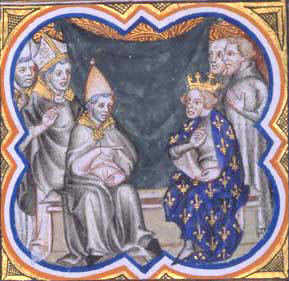 It is usually tragic when one who vividly realizes his lack of aptitude for
a position is forced to accept it. Such was the pathetic situation of the
gentle monk Rainerius who became pope in a stormy time.
It is usually tragic when one who vividly realizes his lack of aptitude for
a position is forced to accept it. Such was the pathetic situation of the
gentle monk Rainerius who became pope in a stormy time.
Rainerius was born in Blera near Faenza in Italy. From his early youth, he
was a monk. Sent to Rome by his monastery, he caught the eye of Gregory
VII, who made him cardinal-priest of St. Clement's. He also became abbot of
St. Lawrence's. Under Urban II he served as legate, and at Urban's death he
was chosen to succeed the crusader pope. Aghast at the thought, Rainerius
fled, but was discovered and brought back. Practically forced to be pope,
he took the name Paschal II.
A mild, peaceable man, Paschal at first seemed to have fallen on happy
days. The formidable Henry IV first abdicated, then died. Henry V, his son,
had overthrown his father and had promised much to the Church. But once
secure on his throne, Henry V was as bad as his father. Paschal condemned
lay investiture, but soon Henry V was marching on Rome with two objectives:
imperial coronation and permission to practice lay investiture.
Paschal made a revolutionary attempt to end the lay investiture quarrel
once and for all by having churchmen give up their feudal possessions. How
then could they live? By alms. The solution was beautiful and simple. Too
simple. The great German prince-bishops and lord-abbots looked bleakly on
the proposal while Henry himself was not enthusiastic. He liked the idea of
great church vassals; all he wanted was to control them. The proposal was
considered, however, and Henry entered Rome peacefully on February 12, 111.
But when the time came for Henry's coronation, the affair exploded in a
stormy scene in St. Peter's. The Germans would not hear of Paschal's plan
to extricate the Church from the octopus grasp of feudal ties. Angrily they
demanded that Paschal crown Henry at once. When Paschal refused, Henry
carried him off a prisoner. The cardinal of Tusculum rallied the Romans and
forced Henry to evacuate the city. But he dragged the Pope with him. At
last when rescue seemed impossible, and Henry brutally threatened to
butcher or mangle the companions of the Pope, the gentle Paschal gave way
and agreed to allow Henry to practice lay investiture. Henry then released
Paschal, followed him to Rome, and was crowned emperor on April 13, 1111.
Scarcely had the news of Paschal's surrender spread when indignant messages
rained in on the poor Pope. He was accused of being weak, which was true;
of being heretical, which was false. The tortured Pope put off the papal
robes and fled to a desert island. Alarmed, the reform party brought him
back. They then prevailed on Paschal to revoke his concession to Henry,
since it was granted by force, and once more condemn lay investiture.
For some years Paschal had peace because Henry was busy in Germany, but in
1117 the Emperor once more took Rome. Paschal fled to Benevento, but soon
he was able to return to Rome. He died there on January 21, 1118. Though
Paschal II had had a tormented pontificate, he did have the satisfaction of
seeing the lay investiture question reasonably settled in England by Henry
I and St. Anselm.
Excerpted from "Popes
Through the Ages" by Joseph Brusher, S.J.

